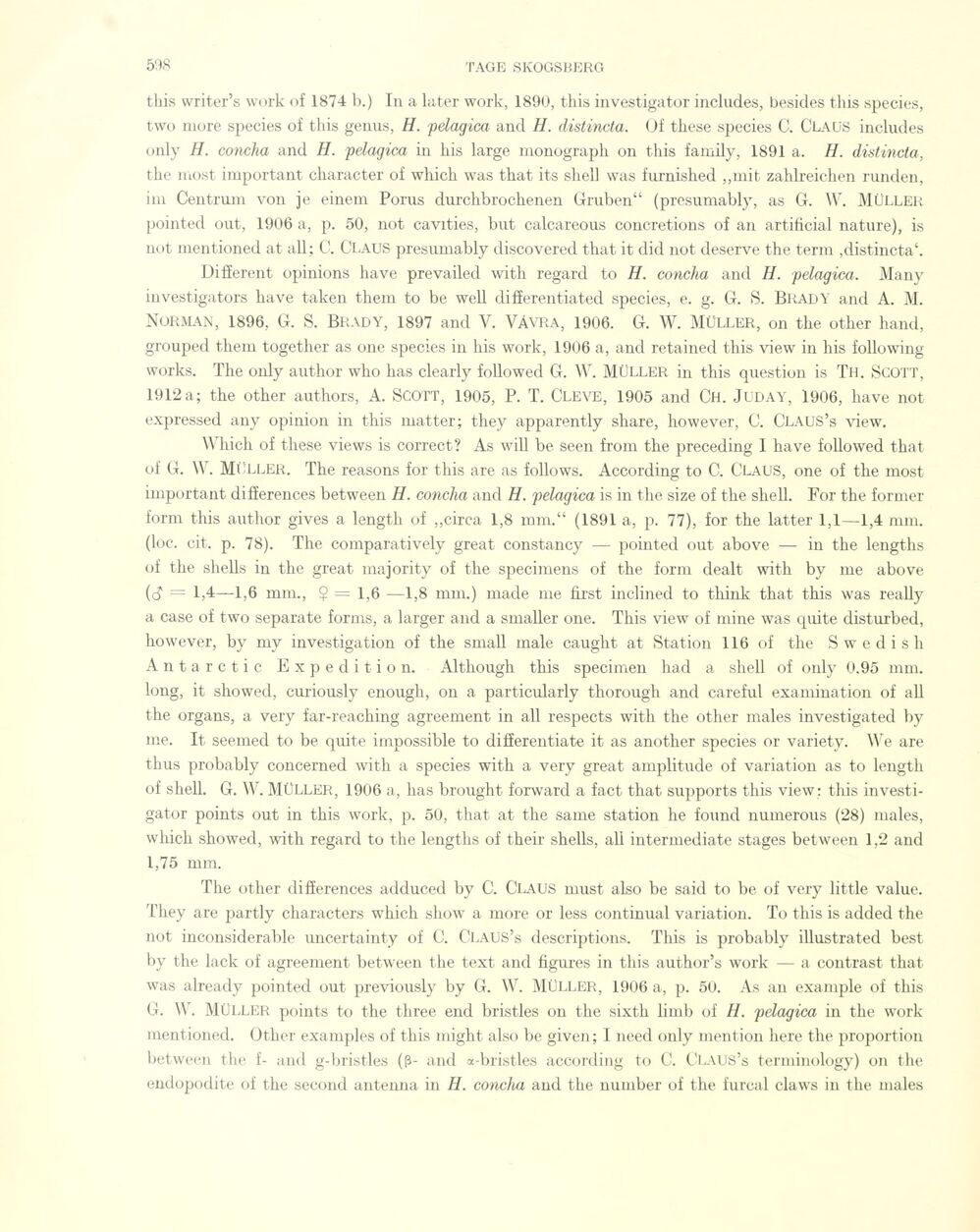
Full resolution (JPEG) - On this page / på denna sida - Sidor ...

<< prev. page << föreg. sida << >> nästa sida >> next page >>
Below is the raw OCR text
from the above scanned image.
Do you see an error? Proofread the page now!
Här nedan syns maskintolkade texten från faksimilbilden ovan.
Ser du något fel? Korrekturläs sidan nu!
This page has never been proofread. / Denna sida har aldrig korrekturlästs.
this writer’s work of 1874 b.) In a later work, 1890, this investigator includes, besides this species,
two more species of this genus, IL pelagica and H. distincta. Of these species C. CLAUS includes
only H. concha and H. pelagica in his large monograph on this family, 1891 a. H. distincta,
the most important character of which was that its shell was furnished ,,mit zahlreichen runden,
im Centrum von je einem Porus durchbrochenen Gruben“ (presumably, as G. W. MÜLLER
pointed out, 1906 a, p. 50, not cavities, but calcareous concrétions of an artificial nature), is
not mentioned at all; C. Claus presumably discovered that it did not deserve the term ,distincta4.
Different opinions have prevailed with regard to H. concha and II. pelagica. Many
investigators have taken them to be well differentiated species, e. g. G. S. BRADY and A. M.
Norman, 1896, G. S. Brady, 1897 and V. VâVRA, 1906. G. W. Müller, on the other hand,
grouped them together as one species in his work, 1906 a, and retained this view in his folio wing
works. The only author who has clearly followed G. W. MÜLLER in this question is Th. Scott,
1912a; the other authors, A. SCOTT, 1905, P. T. Cleve, 1905 and Ch. JUDAY, 1906, have not
expressed any opinion in this matter; they apparently share, however, C. CLAUS’s view.
Which of these views is correct? As will be seen from the preceding I have followed that
of G. W. MÜLLER. The reasons for this are as follows. According to C. Claus, one of the most
important differences between II. concha and H. pelagica is in the size of the shell. For the former
form this author gives a length of „circa 1,8 mm.“ (1891 a, p. 77), for the latter 1,1—1,4 mm.
(loc. cit. p. 78). The comparativelv great constancy — pointed out above — in the lengths
of the shells in the great majority of the specimens of the form dealt with by me above
(o* = 1,4—1,6 mm., $ = 1,6 —1,8 mm.) made me first inclined to think that this was really
a case of two separate forms, a larger and a smaller one. This view of mine was quite disturbed,
however, by my investigation of the small male caught at Station 116 of the Swedish
Ant arctic Expedition. Although this specimen had a shell of only 0.95 mm.
long, it showed, curiously enough, on a particularly thorough and careful examination of all
the organs, a very far-reaching agreement in all respects with the other males investigated by
me. It seemed to be quite impossible to differentiate it as another species or variety. We are
thus probably concerned with a species with a very great amplitude of variation as to length
of shell. G. W. Müller, 1906 a, has brought forward a faet that supports this view: this
investigator points out in this work, p. 50, that at the same station he found numerous (28) males,
which showed, with regard to the lengths of their shells, all intermediate stages between 1,2 and
1,75 mm.
The other differences adduced by C. Claus must also be said to be of very little value.
They are partly characters which show a more or less continuai variation. To this is added the
not inconsiderable uncertainty of C. CLAUS’s descriptions. This is probably illustrated best
by the lack of agreement between the text and figures in this author’s work — a contrast that
was already pointed out previously by G. W. MÜLLER, 1906 a, p. 50. As an example of this
G. IV. Müller points to the three end bristles on the sixth limb of H. pelagica in the work
mentioned. Other examples of this might also be given ; I need only mention here the proportion
between the f- and g-bristles (ß- and a-bristles according to C. CLAUS’s terminology) on the
endopodite of the second antenna in H. conclut and the number of the furcal claws in the males
<< prev. page << föreg. sida << >> nästa sida >> next page >>